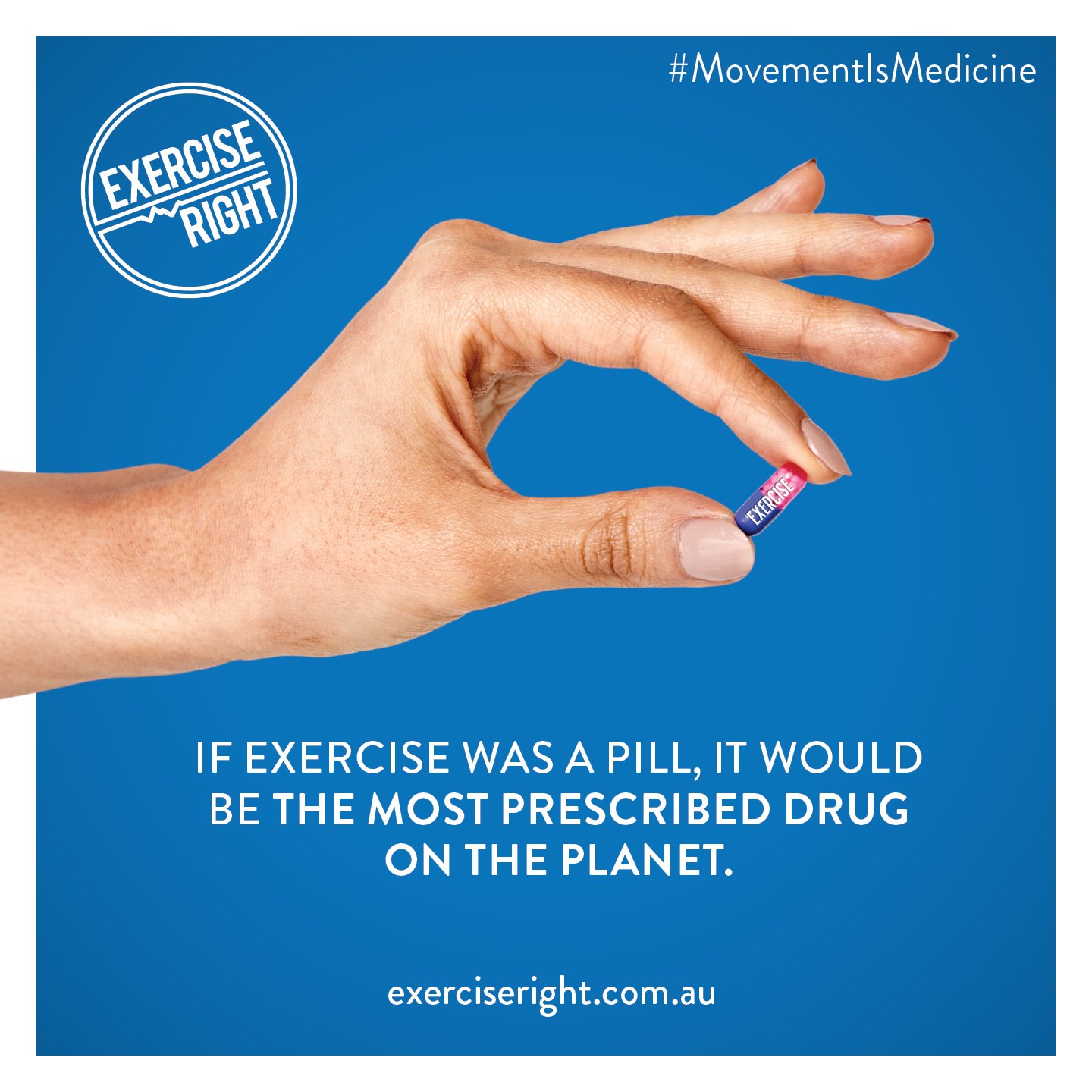It’s Exercise Right Week, May 25th-31st 2020, and the theme this year is “Movement Is Medicine.”
Let’s explore this, through the lenses of Return to Work and Return to Life, because that’s what we specialise in!
Exercise and Medicine – Definitions

When most people think “medicine” they think “pill.”
There are two general meanings of medicine in the western world:
- “The science or practice of the diagnosis, treatment, and prevention of disease”
- “A drug or other preparation for the treatment or prevention of disease”
– Oxford Dictionary
Of course, exercise is not a drug, however, it does have direct physiological and biochemical effects on the body, so it can technically be viewed as a type of medicine.
The definition of exercise is:
“Physical activity consisting of planned, structured, and repetitive bodily movement done to improve and/or maintain one or more components of physical fitness.”
- American College of Sports Medicine.
So, when we are talking “Movement is Medicine” – we are referring to manners of treatment and prevention of disease through prescribed physical activity.
Exercise is Medicine in RTW

With any condition, there is usually a team of health providers on the case.
Exercise physiologists studied and practice the science of all things exercise, and are one option in the multitude of health practitioners available.
For the best outcomes, claimants should be seeing the relevant health professional to be getting the right medicine for them.
If a claimant needs exercise, they need to Exercise Right. To do so, they need to see the exercise professionals – exercise physiologists.
As a silly, obvious example, you wouldn’t send someone who has a broken leg, to an optometrist if their goal is to increase physical strength.
So, make sure you’ve considered what your claimant’s goals are and which provider can best help.
For an explanation of the difference between physio (acute) and exercise physiology (chronic) check out our previous article here.
Let’s put it in RTW terms, considering the definition of “Treatment or Prevention,” and adding in the element of “Conditioning.”
Treatment
In CTP and WorkCover, exercise physiology directly addresses the diagnosed condition and consequences of the condition, and a treatment plan is developed with the goal to return to work.
Prevention
In all schemes, CTP, WorkCover and Income Protection, exercise prescription can be used to prevent re-injury and thereby increase sustainability of the claimant’s return to work.
Conditioning
Specifically in Income Protection, there is a big focus on Conditioning.
In medical/health terms, perhaps it could be similar to Prevention with some extra drops of “Bio-hacking.”
Conditioning programs look at the whole individual, not necessarily the diagnosis, and prescribe accordingly, to optimise function and return to work and/or life.
Exercise Prescription

Like any medication it needs to be prescribed to the individual.
Prescription needs to consider the purpose or expected outcome, other drug interactions, comorbidities, side effects, and optimal dosage.
The outcome, of course, for us is usually Return to Work and/or Life involving hobbies and household chores.
What that means to any one claimant can vary depending on the condition, their vocational roles, lifestyle, personal goals and individual barriers.
Optimal dosage includes variables such as type (strength, vs mobility, vs aerobic – or a combination of all), frequency (twice a day, once a day, three times per week), intensity or load as well as duration.
An easy example of interactions would be the consideration of diabetes. If a client is taking medication to lower their blood sugar, exercise can also decrease blood sugar, so it’s important to know that the client may be exposed to a double dose.
Side effects are usually less than traditional “pill” medications, and that’s one of the best things about exercise as a medicine – less side effects!
That said there can be side effects, particularly early in the program where tolerances are being assessed. In this case, the exercise physiologist would communicate with the claimant what to expect and how to manage it.
Who Should See An Exercise Physiologist?

Ok, here we may be accused of bias… But is it bias if we consistently get results and achieve the outcomes?
Basically, if you have a claimant that needs to improve daily stamina and function to be able to get back to a normal life, we can help. If exercise can help, exercise right with exercise physiologists.
Common conditions we see include musculoskeletal injuries, chronic fatigue, chronic pain, mental health and cancer.
Here’s an article we wrote about some more conditions we see that might surprise you.
Specialised Health’s EPs

All of our EPs are professionals at exercise assessment and prescription, but at Specialised Health we’re smashing results by prioritising two things:
- Focus on biopsychosocial factors by addressing stress management, healthy eating, goal setting, education and empowerment to self-manage
- Working in a team environment with a high focus on communication with case managers, rehab providers and other health providers on file.
So, if you want to work with us, don’t be shy, we’d love to work with you too! Check out our website or contact us here.

Biara Webster, Exercise Physiologist & Content Manager

 Each month we will pick a question to Q&A.
Each month we will pick a question to Q&A.




